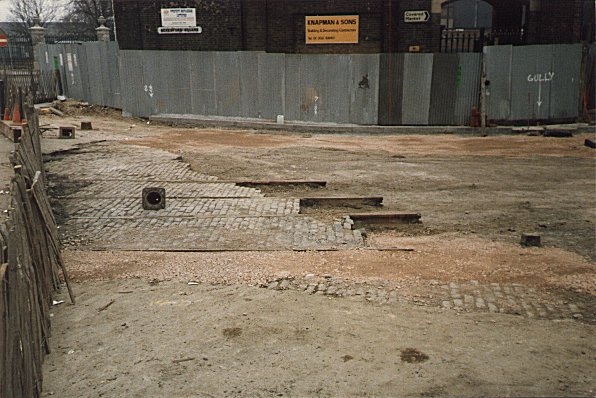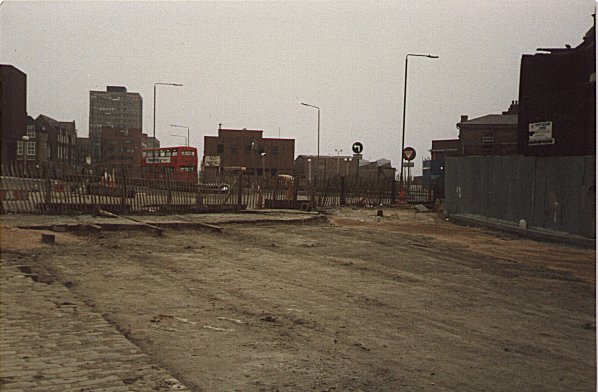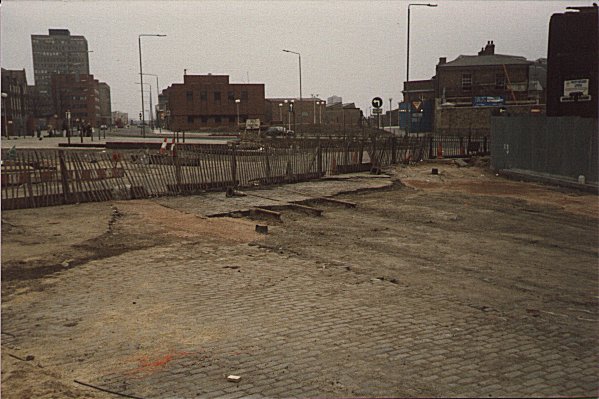

| The last tram passed this way on the night of 5 July 1952. They were
the last of London's tram routes. Most places the tracks were torn up soon
after the last trams passed. A few places however they were left behind
for one reason or another. The most notable being the Northern portal of
the Kingsway Subway. In Beresford Square Woolwich the track to link the
Eltham services to Greenwich could be seen in the cobbles for years afterwards.
(See
Woolwich page). However the rails in front of the gates on the Abbey
Wood - London services must have just been covered with tarmac. In the
late 1980's A new main road was laid to the North of the gates to The Royal
Arsenal. In the picture above the gates can be seen behind a fence awaiting
restoration. The new gates to the arsenal can be seen behind on the other
side of the new road.
Photograph John King. |

| The work here is to level the ground ready to pave over Beresford Square
to extend Woolwich Market. It looks like part of the rails are being removed
to enable the road to be lowered. The Granite setts of the Market can be
clearly seen in these photographs. It can be seen that they lay quite deep
under the raod surface in some places.
Photograph John King. |

| In this picture the new road can be clearly seen. Riverside Hose is
the tall building on the left of the picture, with Sovereign House in front
of it. The older brick building is Woolwich Polytechnic School. The building
on the right is Woolwich Catholic Club. The whole of Beresford Square has
now been paved over, and the gates to the Royal Arsenal, have, after a
number of years laying derelict been fully restored. It was in front of
these gates that the policeman stood on point duty directing traffic, with
a long queues waiting in Beresford Street and Plumstead Road.
( See Woolwich in the rain) One policeman it particular, a PC Sidney Brandon, it seemed had an aversion to trams, and would issue a summons for the most trivial traffic offence. One day it nearly led to a strike of tram drivers, it was averted by transferring the constable. to other more suitable duties. Photograph John King. |
| Chris 'fufas' Grace (chris@transdata.co.nz) writes:-
You state on your web site that most tram tracks were pulled up after
the services ended. This was certainly the case on the tracks abandoned
after the war, because the steel they were made from was almost armament
grade and in much shortage at the time, fetching excellent prices. However
I'm
I come originally from West London, London United territory, and the first tram services replaced were in the Kingston and Twickenham areas before the foundation of London Transport. In 1967/8 there were major road works in the Twickenham area on the road from Twickenham Green to the town centre. You can imagine my interest when these road works exposed double tram track along the whole road, which sat there for a couple of weeks until the rails were removed. At this time, and at least until 1972, the track fan at Fulwell Depot was still in place complete with cobblestones. Fulwell was a double ended depot and the fans were visible at both ends. The main part of the depot was tarred over in the 70s, but the rear half of the depot was sold or leased to Grundy who used the site to manufacture beer barrels and it may be that tracks are visible in this part of the yard to this day. I certainly recall noticing that their factory yard was cobbled and had not been tarred over. The other site of interest is the Uxbridge Road between Southall and Hayes. This was an LUT tram route which became the LPTB trolleybus route 607 Shepherds Bush - Uxbridge. I think it was converted to trolleybuses in 1935 but prior to this was a haunt of the Feltham tramcars. I was in 562 Parachute Squadron RCT (TA) in the late 1960s. The TA centre is on Uxbridge Road at Hayes Bridge. I was surprised to notice that the tarmac on the Uxbridge Road at this point had worn down and steel tracks were wisible in the road (just the head of the rails - a strip of steel really). This was visible in patches from Southall up to the point where the road became dual carriageway - I understand that there was a stretch of reserved track at this point. I have no idea how much of the Uxbridge Road has been 'Dual Carriagewayed' by now, but I wouldn't mind betting that if there are any stretches of normal two-way road between Southall and Shepherd's bush which haven't been reconstracted in the last 30 years there will be tram tracks underneath the tarmac. This makes me wonder whether the whole of the MET/LUT lines were simply tarred over and how much tramway track still exists hidden from sight. Does anyone know more about this? |
This page was designed and is maintained
by Toby and John King, I would accept any comments or questions See
Index Page